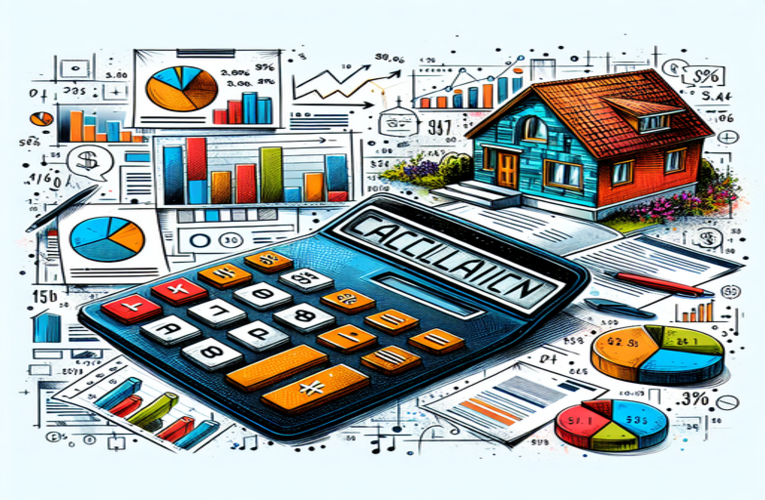How to calculate loan affordability: a comprehensive guide for homebuyers
Understanding how to calculate loan affordability is a critical step for any prospective homebuyer navigating the complex landscape of real estate. Determining your mortgage affordability is not merely about numbers; it’s about making a substantial financial commitment that can have long-lasting implications on your overall financial health. Therefore, having a clear grasp of your borrowing capacity and financial capabilities is essential to avoid the pitfalls of overextending your budget.
In this article, we will explore:
- The key factors that influence your home loan affordability assessment and their significance in real estate transactions.
- Effective methods for calculating your monthly budget, including income assessment and expense tracking, to determine how much you can borrow.
- The role of mortgage affordability calculators and tools in evaluating your borrowing potential.
- Practical strategies for achieving mortgage pre-approval and securing favorable loan terms, ensuring your home loan affordability.
By mastering these aspects, you will become empowered to make informed decisions during your home-buying journey. Not only will you gain insight into your financial situation, but you will also learn how to navigate external market factors that may affect your loan affordability. Prepare to dive into the essential elements of calculating how much you can borrow and equip yourself with the knowledge necessary for successful homeownership.
Purchasing a home is one of the most significant financial commitments an individual can make. Understanding how to calculate loan affordability accurately is essential to ensure a sound investment and avoid financial strain. This process begins with a meticulous assessment of your income, expenses, and existing debts to determine what you can comfortably afford.
Table of Contents
Understanding your financial position
A thorough evaluation of your financial standing is the first step toward determining loan affordability. This involves analyzing your gross and net income, as well as identifying all sources of revenue.
- Gross annual income: Include your salary, wages, bonuses, commissions, and any additional earnings. For instance, if your annual income totals $75,000, your gross monthly income is approximately $6,250. This figure is crucial in establishing your housing budget.
- Net income: Consider your take-home pay after taxes and deductions, as this reflects the actual funds available for expenses.
- Additional income sources: Account for freelance work, rental income, dividends, or other passive income streams to obtain a comprehensive view of your financial capacity.
Understanding your total income provides a solid foundation for calculating how much you can allocate toward a mortgage without compromising other financial obligations.
Applying the 28/36 rule
The 28/36 rule is a standard guideline used by lenders to evaluate loan affordability. It helps you understand your financial limits and maintain a healthy debt balance.
- Housing expenses (28% limit): Your total monthly housing costs—including mortgage payments, property taxes, and homeowners insurance—should not exceed 28% of your gross monthly income. With an annual income of $75,000, a responsible monthly housing expenditure would be about $1,750.
- Total debt payments (36% limit): Your combined monthly debts, such as car loans, student loans, and credit card payments, should remain below 36% of your gross monthly income, equating to $2,250 in this scenario.
Adhering to the 28/36 rule ensures you have sufficient income remaining for other expenses and savings goals, reducing the risk of financial stress.
Calculating your debt-to-income ratio
The debt-to-income (DTI) ratio is a critical metric used by lenders to assess your ability to manage debt payments.
To calculate your DTI ratio:
- Add up all your monthly debt obligations, including the potential new mortgage payment.
- Divide the total monthly debts by your gross monthly income.
- Multiply the result by 100 to get a percentage.
Example: If your total monthly debts are $2,250 and your gross monthly income is $6,250, your DTI ratio is ($2,250 ÷ $6,250) × 100 = 36%.
A DTI ratio below 36% is generally preferred by lenders, but some may allow higher ratios depending on other qualifying factors.
Using a mortgage affordability calculator
Mortgage affordability calculators are valuable tools that provide personalized estimates of how much you can borrow. By inputting your income, debts, and down payment amount, you can gain a clearer understanding of your loan affordability.
Consider additional factors that influence affordability:
- Interest rates: Even a slight change in interest rates can significantly affect monthly payments. For example, a $300,000 loan at 4% interest over 30 years results in a monthly payment of approximately $1,432. If the rate increases to 5%, the payment rises to about $1,610.
- Credit score: A higher credit score can secure lower interest rates, improving affordability. Review your credit report for accuracy and take steps to improve your score if necessary.
- Loan term: Choosing between a 15-year and a 30-year mortgage affects your monthly payments and the total interest paid over the life of the loan.
Accounting for ongoing homeownership costs
Beyond the mortgage payment, homeownership includes additional costs that should be factored into your affordability calculations.
- Closing costs: Typically ranging from 2% to 5% of the loan amount, these fees cover expenses like appraisal, title insurance, and loan origination fees.
- Property taxes and insurance: These costs vary by location and property value. Obtain accurate estimates to include in your budget.
- Homeowners association (HOA) fees: If applicable, HOA fees cover maintenance of common areas and amenities.
- Maintenance and repairs: Allocate funds for routine maintenance and unexpected repairs. A common recommendation is to set aside 1% of the home’s value each year.
- Utilities and ongoing expenses: Utilities, internet, and other recurring expenses should be included in your monthly budget.
By preparing for these costs, you can prevent unforeseen financial burdens and ensure sustainable homeownership.
Improving your loan affordability
If your calculations reveal that your desired home is currently out of reach, consider strategies to enhance your loan affordability.
- Increase your down payment: Saving for a larger down payment reduces the loan amount and may eliminate the need for private mortgage insurance (PMI).
- Reduce existing debts: Paying down debts improves your DTI ratio and can qualify you for better loan terms.
- Enhance your credit score: Higher credit scores often lead to lower interest rates. Pay bills on time, reduce credit card balances, and avoid new debt.
- Adjust your budget: Reevaluating and reducing discretionary spending can free up additional funds for a mortgage payment.
- Explore different loan programs: Government-backed loans like FHA, VA, or USDA loans may offer more favorable terms or lower down payment requirements.
Implementing these steps can increase your purchasing power and bring your homeownership goals within reach.
Key factors influencing loan affordability calculations
Several critical factors impact your ability to afford a home loan. Understanding these elements helps you make informed decisions and prepares you for discussions with lenders.
Assessing total monthly income
A comprehensive evaluation of your income ensures an accurate affordability calculation.
- Primary income: Your gross income from employment forms the base of your calculation.
- Secondary income: Include earnings from part-time jobs, overtime, bonuses, and commissions.
- Passive income: Rental properties, dividends, interest, and other investments contribute to your overall financial picture.
- Household income: If purchasing with a partner, combine incomes to increase overall affordability.
Compiling monthly expenditures
Listing all expenses helps determine how much you can allocate toward a mortgage without overextending your finances.
- Existing debts: Account for student loans, car payments, credit card debts, and other liabilities.
- Living expenses: Include utilities, groceries, transportation, insurance premiums, childcare, and healthcare costs.
- Discretionary spending: Entertainment, dining out, hobbies, and other non-essential expenses.
- Savings contributions: Regular deposits to retirement accounts, emergency funds, and other savings goals.
Understanding lender criteria
Lenders evaluate specific metrics to determine loan eligibility and terms.
| Metric | Description | Recommendation |
|---|---|---|
| Debt-to-income (DTI) ratio | Percentage of monthly income used to pay debts. | Aim for a DTI below 36% for favorable loan terms. |
| Credit score | Indicator of creditworthiness based on credit history. | Maintain a score of 700 or higher for better interest rates. |
| Loan-to-value (LTV) ratio | Ratio of the loan amount to the property’s appraised value. | An LTV of 80% or less is preferred to avoid PMI. |
| Employment history | Length and stability of employment. | At least two years in the same field is advantageous. |
Understanding these factors allows you to address potential issues before applying for a mortgage.
Using mortgage affordability tools
Digital tools can simplify the process of calculating loan affordability.
- Online calculators: Input your financial information to estimate how much you can borrow and what your monthly payments might be.
- Budgeting apps: Track income and expenses to gain insights into your spending habits and identify areas for improvement.
- Credit monitoring services: Stay informed about your credit score and receive alerts about changes that could affect loan eligibility.
Utilizing these resources provides a clearer picture of your financial readiness for homeownership.
Steps and tools for evaluating loan affordability
Following a structured approach ensures a thorough assessment of your loan affordability.
Compiling income sources
Gather documentation for all income to present an accurate representation to lenders.
- Pay stubs: Recent pay statements from your employer.
- Tax returns: Typically required for the past two years, especially if self-employed.
- Bank statements: Proof of consistent deposits and financial stability.
- Profit and loss statements: For business owners or freelancers.
Accounting for existing obligations
Detail all current debts and obligations.
- Loan statements: Documentation of balances and monthly payments for all loans.
- Credit card statements: Show current balances and minimum payments.
- Legal obligations: Evidence of alimony, child support, or other mandated payments.
Creating a detailed budget
Developing a budget helps identify how much you can afford to spend on housing.
- Fixed expenses: List all non-negotiable monthly costs.
- Variable expenses: Track spending over several months to determine average costs.
- Potential savings: Identify areas where you can cut back to increase affordability.
Utilizing professional financial advice
Seeking expert guidance can enhance your understanding and planning.
- Financial advisors: Provide personalized strategies based on your financial goals.
- Mortgage brokers: Offer insights into different loan products and help find the best fit.
- Credit counselors: Assist in improving credit scores and managing debt.
Monitoring mortgage market trends
Stay informed about factors that can affect loan affordability.
- Interest rates: Regularly check current rates and forecasts.
- Housing market conditions: Understand whether it’s a buyer’s or seller’s market.
- Economic indicators: Keep an eye on employment rates and inflation.
Preparing your mortgage application
Organize necessary documents to streamline the application process.
- Identification: Government-issued photo IDs.
- Proof of income: Employment verification letters and pay stubs.
- Asset statements: Document savings, investments, and other assets.
- Rental history: Provide proof of timely rent payments if applicable.
Being well-prepared demonstrates to lenders that you are a serious and responsible borrower, which can positively impact loan approval chances and terms.
Summary
Understanding how to calculate loan affordability is essential for prospective homebuyers to make informed financial decisions. Accurately assessing your loan affordability involves evaluating various financial factors and utilizing appropriate tools. Here are the main points to consider:
- Key Factors Influencing Affordability: Evaluate your total monthly income and monthly expenditures, including debts and living costs, to accurately determine your loan affordability.
- 28/36 Rule: Allocate no more than 28% of your gross monthly income to housing expenses and 36% for total debts, ensuring a manageable debt-to-income ratio.
- Mortgage Affordability Calculators: Utilize these online tools to estimate your borrowing potential based on income, debts, and down payment, aiding in effective loan affordability calculation.
- Debt-to-Income Ratio: Maintain a ratio below 36% for better mortgage prospects and to support sustainable loan repayment.
- Consider Ongoing Costs: Factor in expenses like closing costs, homeowners association fees, and maintenance when budgeting for your loan affordability assessment.
Following these guidelines will help you navigate the home-buying process wisely, ensuring a sustainable financial future. Preparing documentation and monitoring current market trends will further enhance your ability to secure a favorable mortgage. Take charge of your finances and equip yourself for successful homeownership.
Frequently Asked Questions
What factors can influence my credit rating when applying for a mortgage loan?
Several elements affect your credit score, including your payment history, credit utilization ratio, length of credit history, variety of credit accounts, and recent credit inquiries. Consistently making on-time payments for your bills and reducing credit card balances can positively impact your credit standing.
Should I prioritize saving for a larger down payment or focus on paying off existing debts first when seeking a home loan?
This decision depends on your overall financial situation. A substantial down payment can lower your monthly mortgage payments and potentially eliminate the need for private mortgage insurance (PMI). Conversely, paying off debts can improve your debt-to-income (DTI) ratio, which is crucial for mortgage approval. Evaluate both options to determine which strategy aligns best with your financial goals and homeownership plans.
How can I enhance my debt-to-income (DTI) ratio to qualify for a mortgage?
You can improve your DTI ratio by either increasing your income through raises or side jobs or by reducing your monthly debts, such as paying off loans or credit card balances. Regularly reviewing and adjusting your budget can also help identify and eliminate unnecessary expenses, thereby strengthening your DTI ratio and enhancing your eligibility for a home loan.
What are the advantages of getting pre-approved for a mortgage loan?
Obtaining pre-approval for a mortgage offers several benefits, including a clearer understanding of your budget, increased negotiating power with sellers, and a faster closing process since most of your financial verification is already completed. Additionally, mortgage pre-approval demonstrates to sellers that you are a serious and qualified buyer, which can be advantageous in competitive housing markets.
What ongoing expenses should I plan for in addition to my mortgage payment?
Beyond your mortgage payment, it’s important to budget for property taxes, homeowners insurance, utilities, maintenance costs, and homeowners association (HOA) fees if applicable. Factoring in these ongoing expenses provides a comprehensive view of your homeownership costs, ensuring you are financially prepared for all aspects of owning a property.
How frequently should I assess my financial situation when preparing to purchase a home?
It’s advisable to regularly review your financial situation, ideally every few months, leading up to your home purchase. This practice allows you to account for changes in income, expenses, and credit scores, helping you stay on track with your savings goals and mortgage qualification requirements. Regular financial assessments can also help you make informed decisions throughout the home buying process.
Can rental income be considered when qualifying for a mortgage loan?
Yes, rental income can often be included when calculating your total income for mortgage qualification. However, lenders typically require a proven track record of receiving that income for a specific period. Be prepared to provide documentation such as rental agreements, lease contracts, and tax returns to verify the stability and consistency of your rental income.
How does the current economic climate affect loan affordability and mortgage rates?
The economy plays a significant role in loan affordability by influencing interest rates, housing supply, and demand. For example, a strong economy may lead to rising property prices and higher interest rates, making mortgages more expensive. Conversely, a weaker economy might result in lower property values and reduced interest rates, potentially making home financing more accessible. Understanding economic trends can help you make informed decisions about the timing and terms of your mortgage application.




















